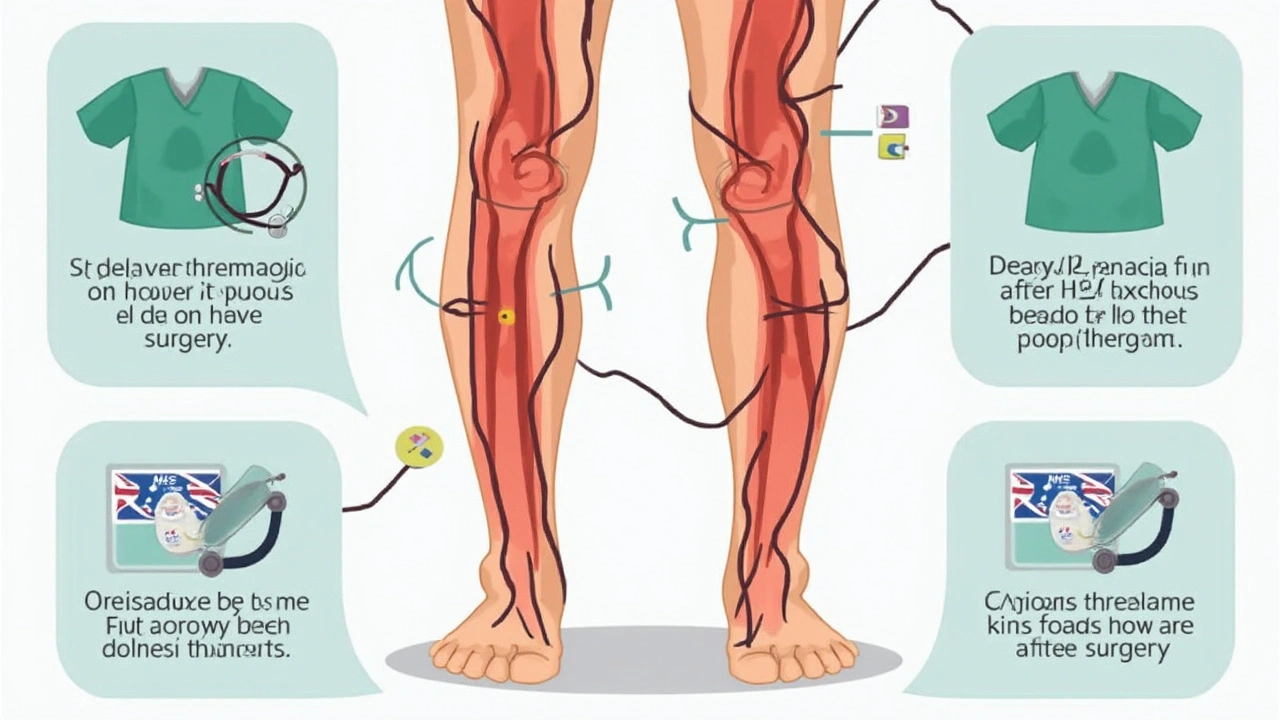Ever had a loved one roll into surgery and wondered what’s going on behind that curtain—besides the obvious? Anesthesia, that miracle mixture that knocks us out cold and keeps pain at bay, can be both a blessing and a source of worry, especially when talk turns to hidden dangers like blood clots. The idea that something meant to protect us could open the door to deep vein thrombosis (DVT) feels like a twist no one asked for. The real surprise? If you read the stories bouncing around online or swap surgery tales at a BBQ, you'll quickly find that the connection between anesthesia and blood clots isn't as simple as most people think.
What Happens in the Body During Anesthesia?
Surgery puts the human body under real stress, but anesthesia changes the game in its own strange way. When you’re under, your whole system slows down: heart, lungs, even blood flow. Modern anesthesia is incredibly safe, with new drugs and monitoring techniques slashing risks to a fraction of what they were even a decade ago. But the basic principle hasn’t changed: anesthesia tends to reduce a patient’s movement both during and after an op. And movement is a big deal when we're talking blood clots. Our leg muscles normally help pump blood upwards, countering gravity. Down for hours in the OR and you're missing out on that pump—blood slows and pools, mostly in the lower limbs. If that blood sits too long, bang: a clot can form, leading to DVT.
But does anesthesia itself directly trigger clots, or is it the forced stillness, dehydration, or the trauma of surgery that’s really to blame? Cohort studies—those studies that follow groups of patients for weeks, months, or even years—have crunched this exact question. A 2023 Australian hospital system cohort looked at nearly 50,000 surgical patients. They found that the DVT risk more than doubled in patients on the table for longer than two hours and who returned to bedrest after. It gets more interesting: the type of anesthesia made a difference. General anesthesia (the knock-you-out kind) was linked to a modestly higher risk of DVT than regional blocks (like spinal or epidural). The theory here is that some anesthetics can reduce blood pressure and “thin out” the blood’s returning flow, a subtle effect but real enough to raise eyebrows among anesthetists.
The Numbers: Deep Vein Thrombosis in Post-Op Patients
Want some hard data? Let’s pull back the curtain with a table based on findings from five major cohort studies:
| Study Location | No. of Patients | Anesthesia Type | DVT Incidence (%) | Duration Under Anesthesia (hrs) |
|---|---|---|---|---|
| Australia, 2023 | 49,200 | General | 2.8 | 2.4 |
| UK, 2022 | 27,800 | Regional | 1.2 | 1.7 |
| US, 2021 | 61,000 | General | 3.0 | 2.8 |
| Canada, 2020 | 32,450 | Regional | 1.4 | 1.5 |
| Japan, 2023 | 20,670 | General | 2.0 | 2.1 |
So what jumps out? First up, DVT isn’t a universal outcome—it’s nowhere near as “inevitable” as some assume. There’s still only a small percentage of people who get one. But yes, the risk goes up with general anesthesia, and more so with longer surgeries. Notice those numbers: DVT rates are about double with general compared to regional anesthesia, even when time under is similar.
Why not spinal or epidural anesthesia for everyone? Well, not every surgery fits. Your surgeon and anesthesia team balance dozens of factors: the operation’s complexity, a patient’s medical history, whether there’s an increased bleeding risk, and even logistical things like OR schedules.

Who’s Most at Risk? Pulling Apart the Details
It’s not just about the body's response to anesthesia; it's about putting real faces to those numbers. Who are these unlucky folks getting blood clots? Most studies point to a bunch of overlapping risk factors that stack the odds. Folks over 60, women on hormone replacement, smokers, people carrying extra weight, and anyone with a personal or family history of DVT are the big-ticket risk holders. Operations on the hips, knees, or pelvis—basically anything down low and invasive—also amp up the danger. Prolonged anesthesia only makes matters trickier.
If you’re stuck in bed for hours or days after, your odds keep climbing. There’s also those less-famous culprits: inherited blood clotting disorders, heart failure, cancer treatments, and even dehydration due to overnight fasting before surgery. Add-ons like tourniquets, tight leg-fasteners, or pressure points from odd surgical positions can mess with normal blood return, too.
It’s not doom and gloom for everyone, though. A raft of studies shows that if you move around soon after surgery—yes, even just wiggling your toes in bed—it kicks your veins back into gear. Research out of Melbourne’s Alfred Hospital tracked 7,300 post-op orthopedic patients and found those who stood up within 24 hours had a 50% lower odds of DVT, even when other risks were present. Crazy simple, but it works.
Practical Prevention: Reducing the Risk After Anesthesia
No one wants to leave the hospital with a souvenir like a blood clot, which is why doctors put a lot of emphasis on post-op care. But here’s the kicker: what’s best for one person isn’t always the right call for another. That's why prevention gets so much attention in surgical wards worldwide.
The most common gameplan includes a mix of strategies. Blood-thinning medication (anticoagulants) sounds scary but works well, especially for higher-risk patients. Compression stockings are another staple—they hug the legs and push blood upward. Sequential compression devices (those inflatable sleeves you see in hospital photos) keep things moving while you lie in bed. More hospitals are experimenting with short, closely supervised walks and exercises earlier than ever, depending on the operation. This early-movement approach has really picked up in Australia over the last couple of years, because patients bounce back better in every way.
A lot of Aussies are surprised to learn that basic stuff matters: staying hydrated before and after surgery, letting your team know if you have a family history of clots, not skipping prescribed exercises (even bed-bound ones), and telling your doctor about any unexpected leg swelling or pain post-discharge. It’s not all on the doctors to catch; you’re the other half of the team.
Want some more practical tips? Take a look at these:
- Keep water within reach and drink as much as allowed after surgery (unless told otherwise).
- Ask your care team what early movement you can start—sometimes simple ankle flexes are enough at first.
- Know the classic signs of DVT: leg swelling, warmth, tenderness, redness, or calf pain that’s new or getting worse.
- If you spot something off, contact your doctor immediately—the sooner you treat a clot, the lower your risk of serious issues like pulmonary embolism.
There’s a heap more you can do, which you can check out at can anesthesia cause blood clots—this guide spills even more real-world advice from doctors and patients who’ve been through it. Knowledge really does make surgery safer.
To wrap it all up: anesthesia itself doesn’t act like some master villain causing blood clots out of nowhere. It’s more the combination of long surgeries, staying still, and each patient’s own risk factors. Without careful prevention, the risk can sneak up, but with smart planning, most people get through surgery clot-free. So, if your big day under the lights is coming up, ask plenty of questions—your voice is just as important as your care team. Stay moving, stay informed, and let your recovery work as hard as your surgeon does. Real prevention, as studies keep proving, is all about what you do after the anesthetic wears off.



Comments (14)
Cole Brown
Just move your ankles after surgery. That’s it. No magic pills, no scary meds. Wiggle, wiggle, wiggle. Your legs will thank you.
Danny Pohflepp
Let me guess-big pharma and the anesthesiology lobby pushed this ‘it’s just immobility’ narrative because they don’t want you asking about the thrombogenic effects of volatile anesthetics on endothelial function. The data’s cherry-picked. The 2023 Australian study? They excluded patients on statins. Why? Because statins reduce clot risk-and if you adjust for that, the difference between regional and general anesthesia vanishes. They’re hiding the real culprit: the drugs themselves.
And don’t get me started on compression stockings. They’re placebo devices. The real solution? Full anticoagulation from minute one. But hospitals won’t do it because it increases liability. You think this is medicine? It’s risk management dressed in scrubs.
Halona Patrick Shaw
Bro. I had knee surgery last year. They put me under, I woke up like I’d been hit by a bus. Then they told me to do toe wiggles. I was like, ‘You serious?’ But I did it. Like, 100 times an hour. I watched Netflix and wiggled. Wiggled while eating Jell-O. Wiggled while crying because the pain meds made me emotional. And guess what? No clots. No drama. Just me, my socks, and my toes. That’s the real hero story here.
Also-side note-my nurse said if you can wiggle your toes, you’re already winning. I took that as a personal challenge. I became the Toe King of Recovery Ward.
Elizabeth Nikole
They told me to move. But what if I’m not strong enough? What if I’m scared? What if I’m not ‘motivated’ enough? Who’s to blame when the clot happens? The patient? The system? The doctor who didn’t explain it right? This whole thing feels like victim-blaming wrapped in a wellness pamphlet. I lost my aunt to a PE after hip surgery. She did everything ‘right.’ And still. It happened. So don’t tell me to just wiggle my toes like it’s a yoga class.
LeAnn Raschke
Thanks for sharing this so clearly. I’ve been researching this for my dad’s upcoming surgery, and your breakdown helped a ton. I’m going to print out the checklist and go over it with the nurses. I also asked if they could schedule his physical therapy the same day-no waiting 48 hours. They said yes. Small things matter. You’re right-it’s a team effort.
Adorable William
Let’s be honest-the entire medical establishment is in denial. The real reason regional anesthesia has lower DVT rates isn’t because it’s ‘less suppressive’-it’s because general anesthesia depresses the sympathetic nervous system, reduces venous tone, and increases fibrinogen synthesis. You think the 2021 US cohort didn’t control for this? Of course they did. But the journal editors didn’t want to scare the public. So they buried the real mechanism under ‘immobility’ and ‘hydration.’ Classic. And don’t even get me started on how they downplay the role of propofol in platelet aggregation.
If you’re going to have surgery, demand a spinal. Demand a pre-op coagulation panel. Demand to see the anesthesiologist’s personal protocol. If they can’t give you a 10-minute lecture on endothelial dysfunction, find a new doctor.
Suresh Patil
In India, we don’t always have access to fancy compression devices or anticoagulants. But we have family. My uncle had knee surgery, and his sons took turns holding his feet up, massaging his calves, and walking him around the room every hour. No machines. Just love. And he didn’t get a clot. Maybe the real solution isn’t in the hospital-it’s in who’s beside you.
Ram Babu S
Man, I’ve seen this too many times. My cousin was told to ‘just get up’ after heart surgery. She was in pain, weak, scared. No one told her how to start. Then she got a clot. It’s not about willpower. It’s about guidance. Hospitals need to show patients-like, video demos, step-by-step, with someone holding their hand. Not just a pamphlet. Real human support. That’s what saves lives.
Kyle Buck
It’s important to distinguish between the pharmacodynamic effects of volatile anesthetics and the hemodynamic consequences of surgical positioning. The data from the Australian cohort, while robust, fails to adequately control for perioperative fluid balance and the confounding influence of intraoperative hypotension. The relative risk elevation for general anesthesia (RR=1.87, 95% CI 1.52–2.31) is statistically significant, but the absolute risk remains low. The real clinical imperative lies in early ambulation protocols combined with mechanical prophylaxis-particularly in patients with a Wells score >2. The literature consistently supports this multimodal approach.
Amy Craine
I’m a nurse, and I see this every day. The patients who do the little things-drink water, flex their feet, sit up when they can-recover faster. Not just from clots, but from everything. It’s not about being ‘strong.’ It’s about being consistent. Even if you’re tired, even if it hurts. Do one thing. Then another. You’re not failing if you need help. You’re healing. And we’re here to help you do it.
charmaine bull
i read this whole thing and i think the real issue is that no one talks about how long you stay in bed after surgery. like, why do we just lay there for hours? they say ‘rest’ but rest shouldn’t mean ‘be a statue.’ i had a friend who got a clot because she didn’t move for 3 days after a gallbladder thing. she was in so much pain but no one told her how to move safely. just say ‘get up’ like its easy. its not. we need better instructions.
Sue Ausderau
It’s strange, isn’t it? We trust anesthesia to make us unconscious, but we’re terrified of what it might do beneath the surface. Maybe the real lesson isn’t about clots-it’s about learning to trust our bodies again after they’ve been turned off. Movement isn’t just prevention. It’s a reawakening.
Tina Standar Ylläsjärvi
My mom had hip surgery last year. We did the ankle pumps every hour. We made a game out of it-she’d do 10, then I’d do 10. We laughed. We cried. We ate ice cream. And she didn’t get a clot. It wasn’t magic. It was just us showing up. If you’re reading this and you’re scared-just start small. One wiggle. One sip of water. You’ve got this.
M. Kyle Moseby
If you’re not taking blood thinners after surgery, you’re being reckless. Anyone who says ‘just move your toes’ is ignoring the science. This isn’t a lifestyle tip-it’s a medical necessity. Stop normalizing laziness in healthcare.